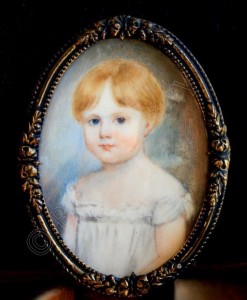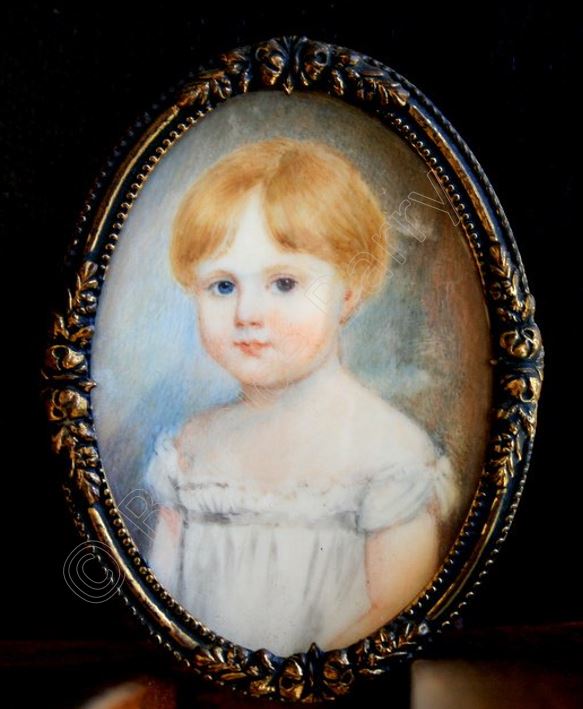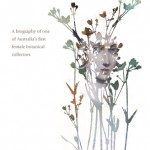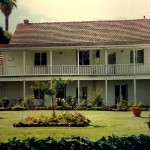Mary Gertrude Birt née Kennedy 1806 – 1846 (younger sister of Georgiana Molloy)
A bit more about… Mary.
Georgiana Molloy wasn’t the only one of the three Kennedy sisters to have a difficult relationship with their mother.
Mary’s letters to Mrs Kennedy usually describe her difficult financial circumstances. She often sounds petulant but the letters she received back from Mrs Kennedy deal with financial matters in the same hard-edged way. Perhaps it isn’t surprising that Mary made such a sudden and surprising decision to marry the young sailor and ex-chorister from Canterbury, ‘Henry’ Birt.
Mary’s childhood portrait shows that she was another beautiful Kennedy girl. Her right arm was noticeably smaller than her left and much weaker. She was only eighteen months younger than Georgiana but by the time she arrived in Western Australia to stay with the Molloys, she was already thirty-three and still single. Her earlier engagement to a neighbour, the eligible son of the local vicar in Crosby-on Eden, had fallen through, suddenly and to her family’s great embarrassment. When the parents began to discuss the finances of a marriage settlement, everything went wrong. Mrs Kennedy was known locally as a wealthy heiress but the death of Georgiana’s father and paying off his debts had left her in a very different situation. John Lowry backed out of his promise, Mary behaved in an ‘unladylike’ way and local people had plenty to gossip about for a while.
Mary went to stay with her father’s relatives at Craig in Scotland and then moved in with Sarah Lodge, the elderly lady who was renting Mrs Kennedy’s house in Abbey Street, Carlisle, where Georgiana was born . Crosby Lodge had also been rented out by then so Mary had no home and received only small allowances of money from her mother. She was convinced that Mrs Kennedy had ruined her chances of happiness by being awkward about what was to be signed over in the marriage agreement and by telling her prospective mother-in-law about her faults – and she made her views clear. ‘You say our family is ruined,’ Mrs Kennedy replied, ‘Ask yourself who ruined it. I again repeat, I have never published your faults, they have published themselves and the concealment of them nearly cost me my life. Now once and for all, send me no more letters like the last or I will return them to you. I am inclined to forgive you if you reform.’
Braving the long voyage and moving in with her sister Georgiana and John Molloy at the Vasse seemed like the only solution but she soon realised it wasn’t the life for her. Even as a little girl, Georgiana’s daughter Sabina recognised her Aunt Mary as ‘spoilt’ and ‘rather weak’. William Henry Birt was on the same ship that Mary arrived on, probably as a crew member, and it was Georgiana who introduced the two. He was thirteen years younger than Mary and had no home, no capital or income apart from wages he earned at sea. Marrying him on board the ship that took her home, living in sailors’ lodgings with the whaling community in America and then finding a room to rent in London might have seemed adventurous and romantic at first but with no money at all, ‘Henry’ had to find a new ship quickly and within weeks she was left alone in a room rented from a woman he had rather tactlessly told her he greatly admired.
Mary found herself in the same old position, living in lodgings on the south coast in Southampton, waiting for any news of her husband, pressuring her mother for money and expecting Henry’s family to provide for her, which they could not. In 1841, soon after Mary was left alone by her husband, with the new experience of a ‘solitary’ married life, Mrs Kennedy wrote to her and signed the letter in a way that seems over formal between mother and daughter even by 19th Century standards: ‘Have you heard from Mr Birt? Your next I hope will contain good accounts, Yours, E.K.’
Mary travelled to Cheltenham to deal with the paperwork when her mother died in May 1843 and was paid for her travel expenses from Mrs Kennedy’s estate, but after that her whereabouts have been impossible to follow. I eventually found her death record, dated between October and December 1846 in the Southampton area of Hampshire, England. With her parents, brothers and sisters all gone, there was no-one who felt the need to mark the sad occasion. So far, I’ve found no announcement in any newspaper.
Mary’s ‘Henry’ married again and became a Master Mariner, though there’s evidence that he may have died a poor man. The Reverend John Stamper Lowry became vicar of Crosby on Eden (like his father) and died there in 1855 at the age of fifty. To date, I haven’t found evidence that he ever married.
Portrait of Mary Kennedy © Bernice Barry, with thanks to Mrs Dorothy M Blaasch née Richardson-Bunbury



